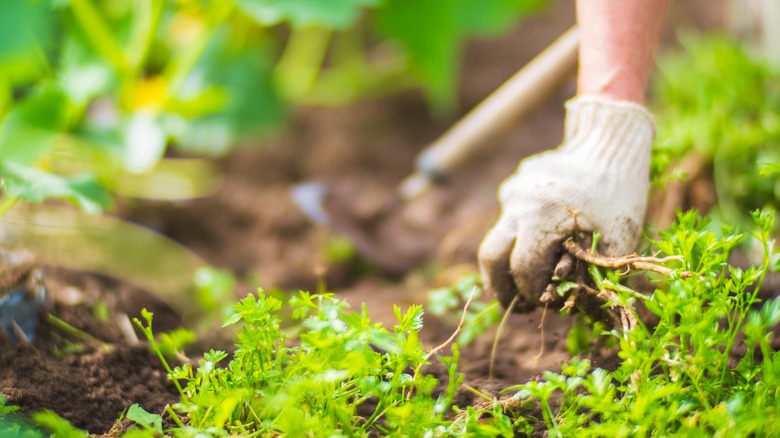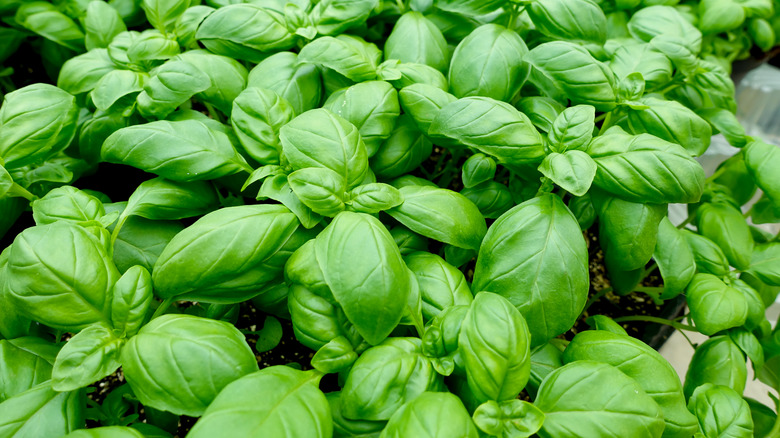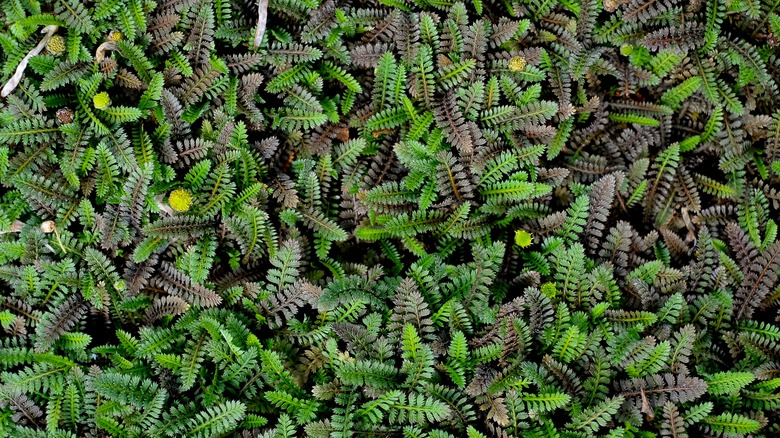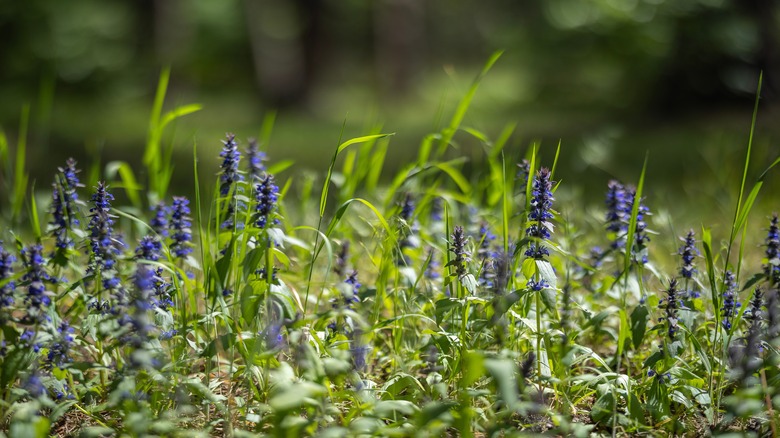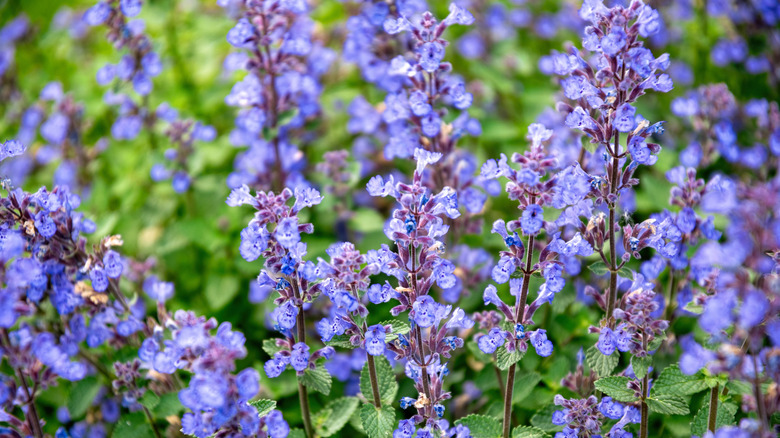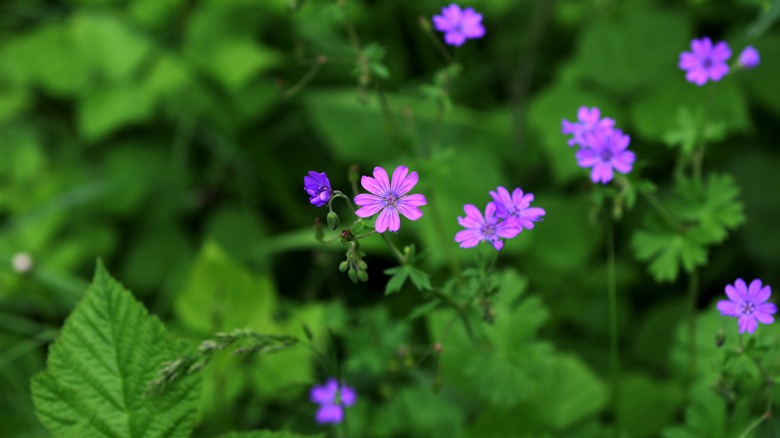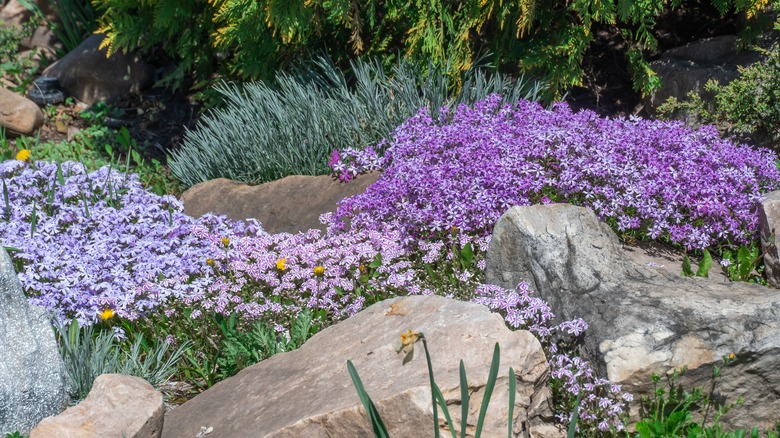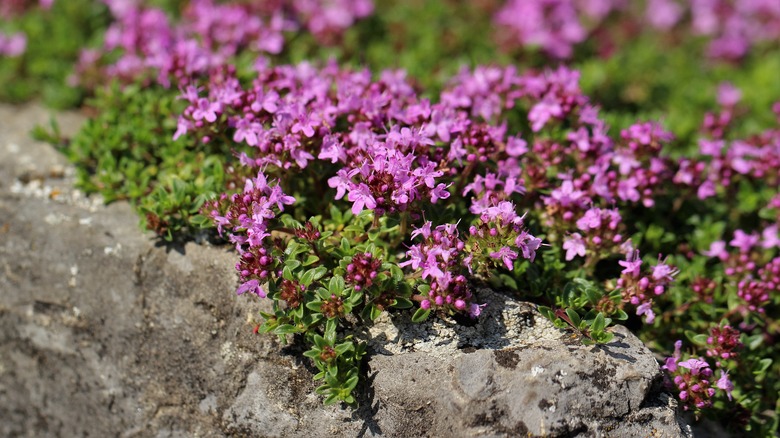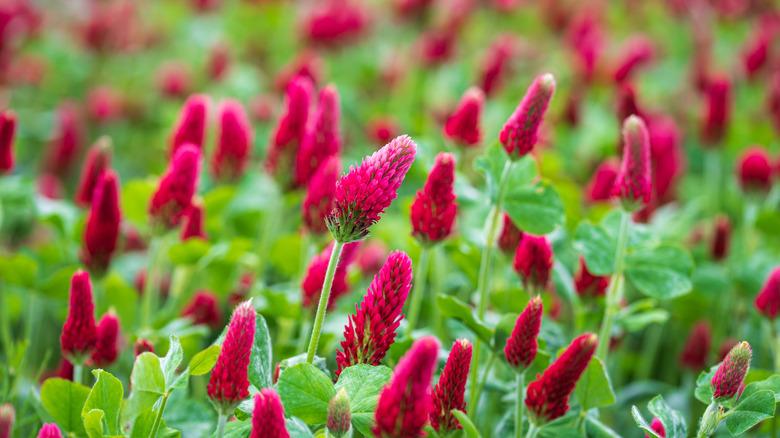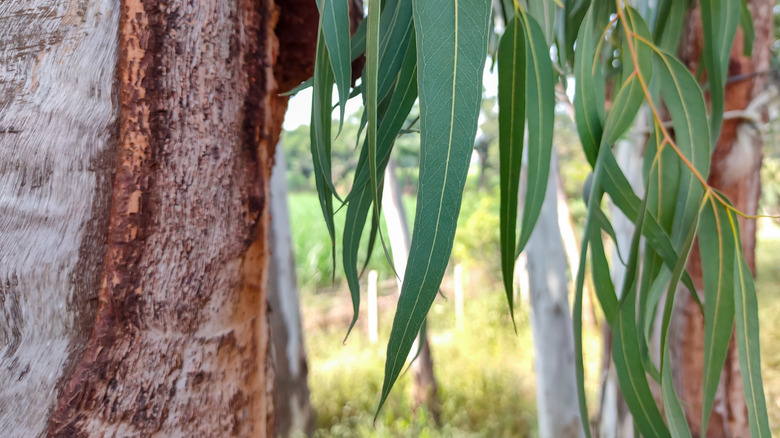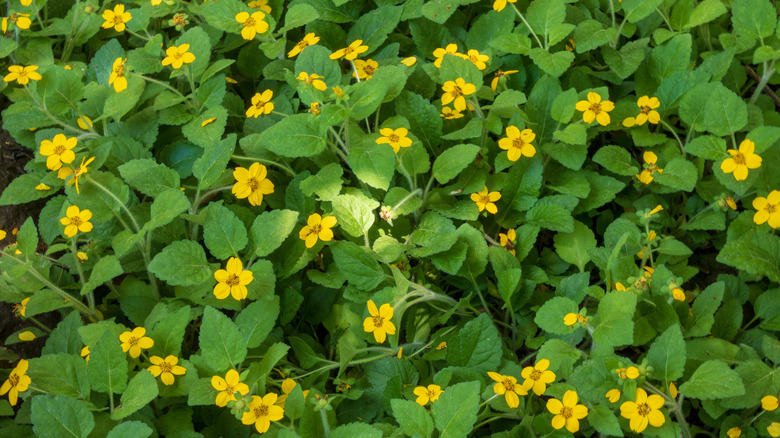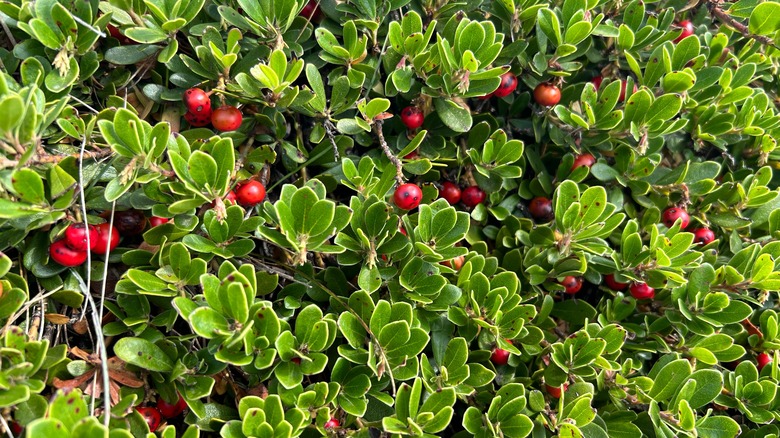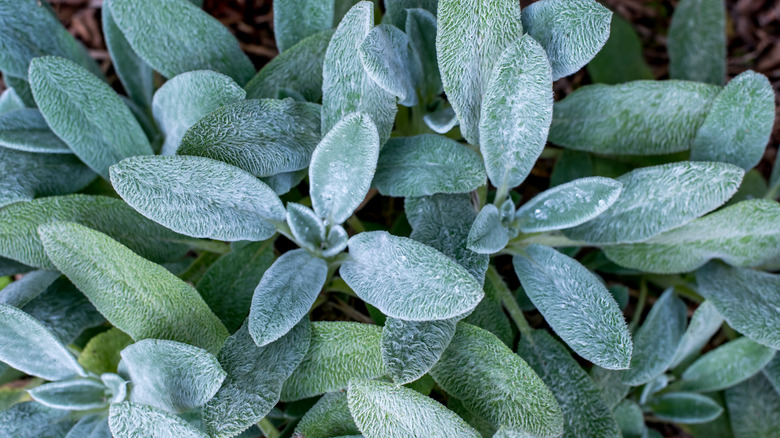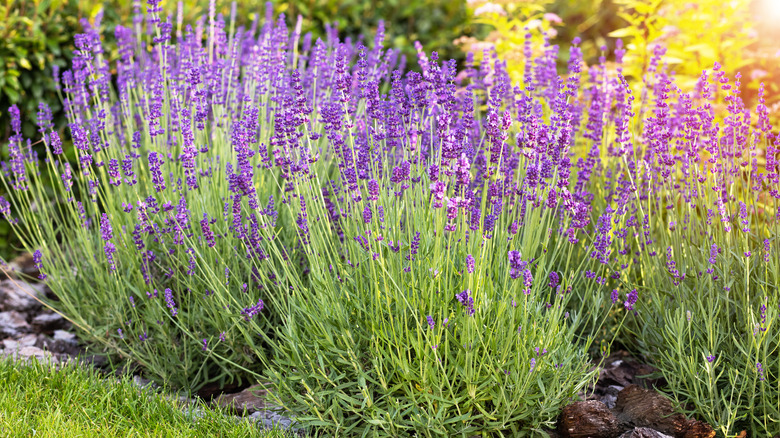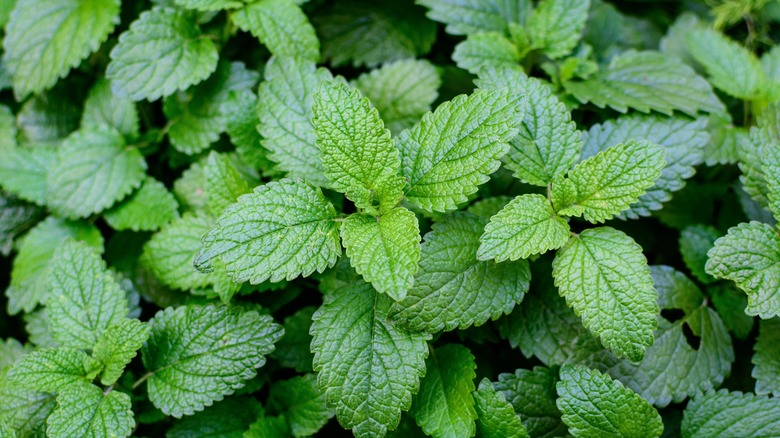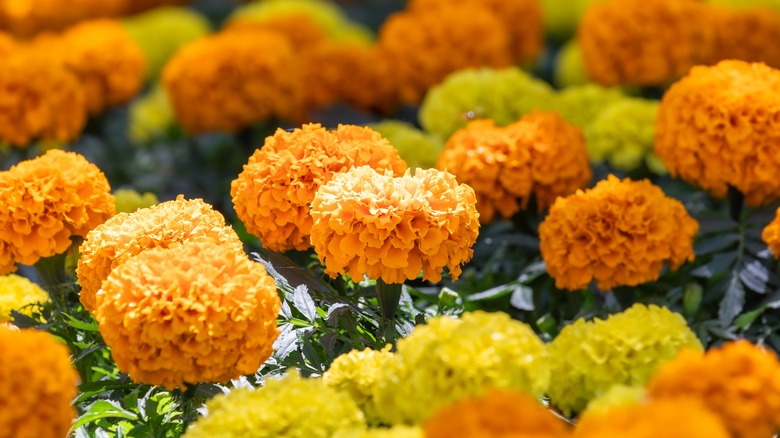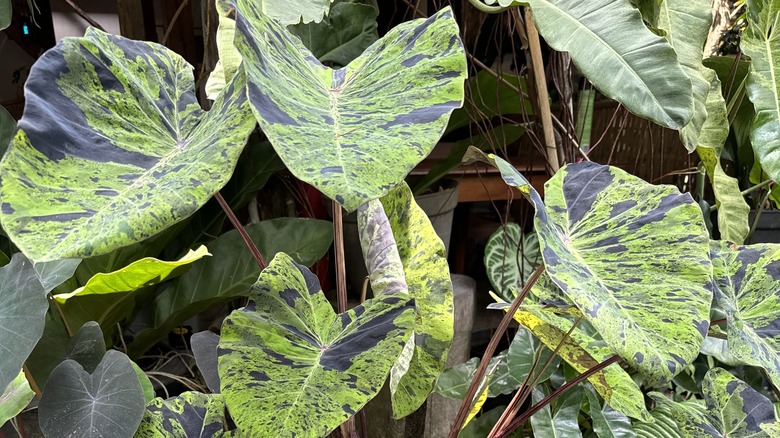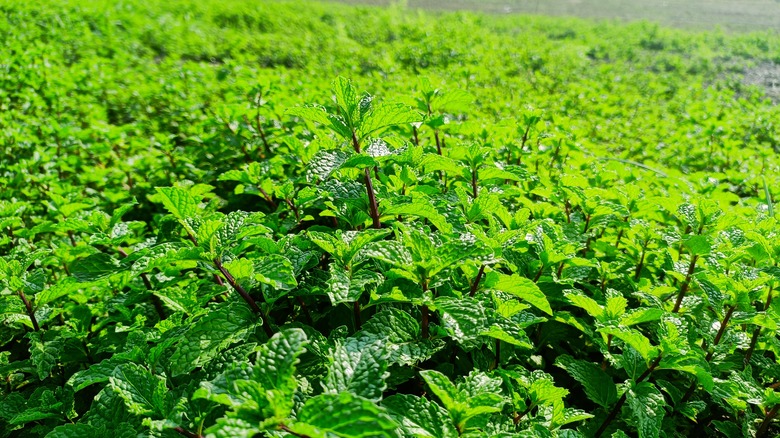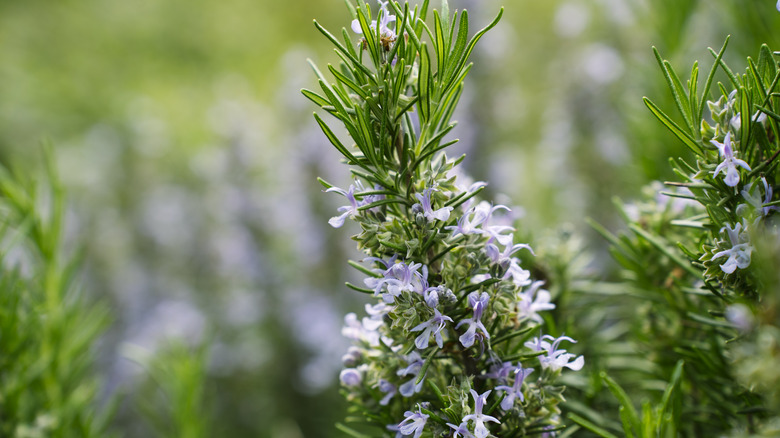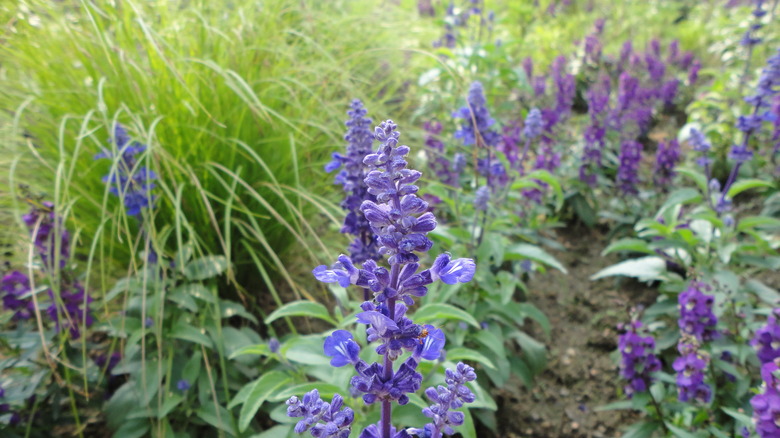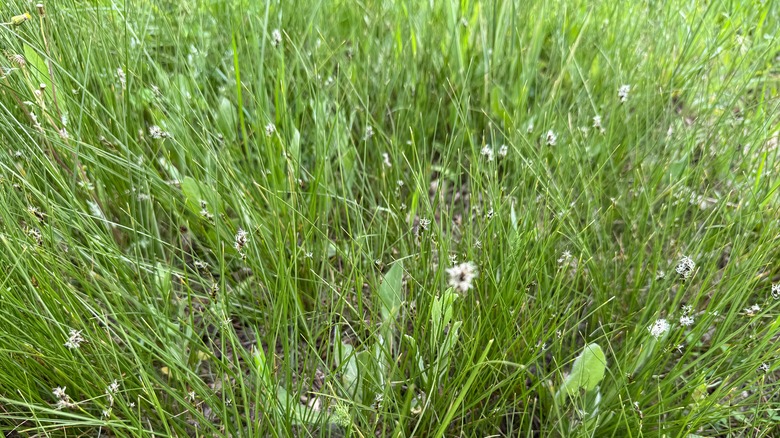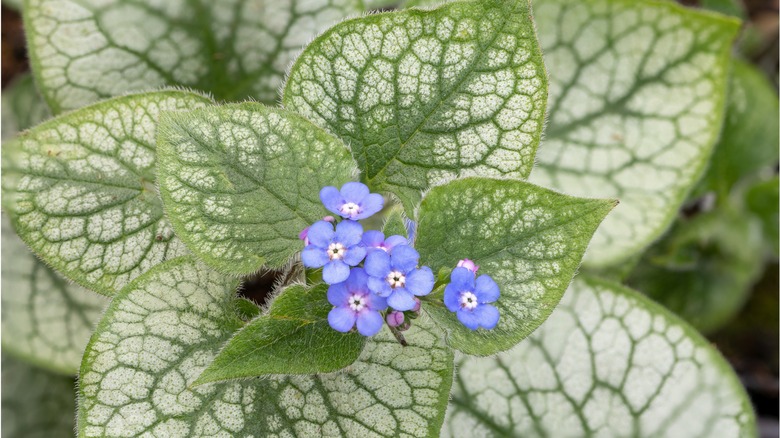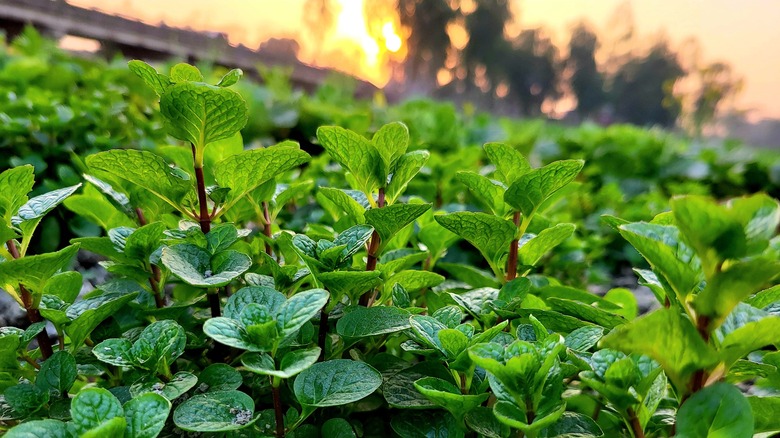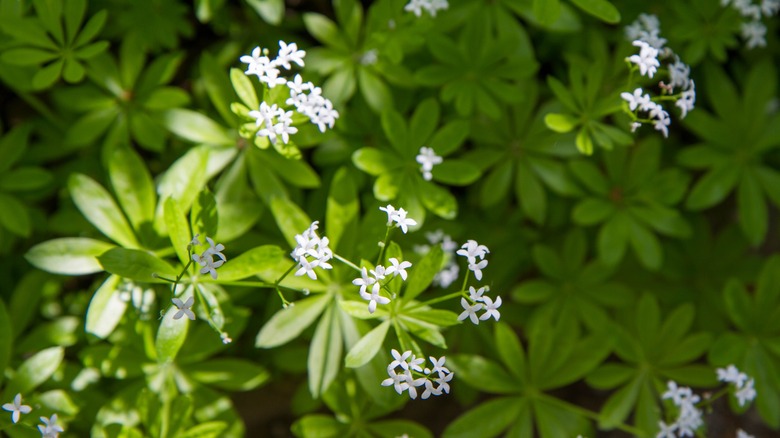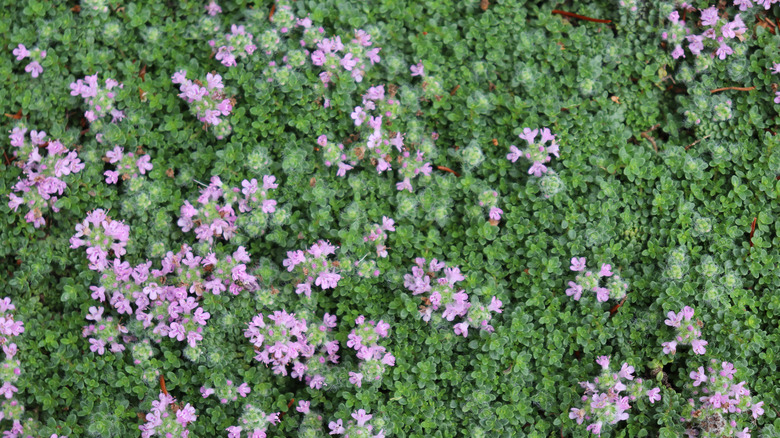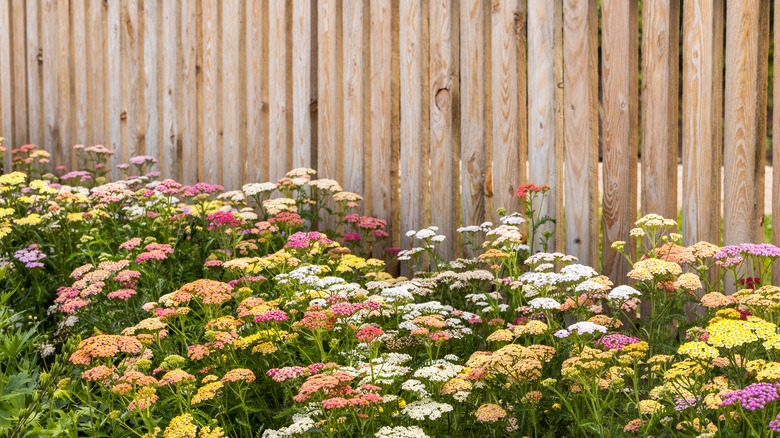25 Plants That Can Help With Garden Soil, Weeds, And Pests
Gardening is a fun and relaxing hobby that provides many benefits. Unfortunately, it can also bring some frustrating downsides that can make gardening feel more like a chore than a hobby. Among these downsides, many gardeners are most annoyed with managing soil conditions, removing weeds, and dealing with damage from pests. Luckily, all hope is not lost. There are some great options for removing weeds and some that aren't worth your time, but adding plants that can help with weeds is a great place to start. In addition, there are several plants that work as natural pest control in your garden.
What's even better, though, is that there are some plants that not only help with weeds but also help with garden soil and pests at the same time! Herbs like basil, thyme, rosemary, mints, and sage improve soil conditions and prevent weeds while producing pungent aromas that insects and damaging wildlife avoid. Alternatively, ground cover like cranesbill, creeping phlox, crimson clover, and brass buttons can keep weeds from coming up by suffocating them while stabilizing the soil and deterring pests with unpleasant textures.
Basil
Basil (Ocimum basilicum) can be planted as a perennial in USDA Hardiness Zone 10 or grown as a warm-season annual in cooler climates. While basil doesn't control weeds on its own, when combined with mulch, it can create enough cover to prevent weeds from getting the sunlight they need to grow. However, basil can also provide benefits to the soil and contribute to pest control. As basil decomposes, it adds essential nutrients to the soil, including carbon mineralization and nitrogen. In addition, the strong scent of basil keeps pests like flies away, but it can still attract aphids and Japanese beetles.
Brass Buttons
Brass buttons (Leptinella squalida) is a type of perennial ground cover from the daisy family that grows in zones 4 through 10. This low-maintenance plant is known for providing quality ground cover that can be paired with other plants to improve growing conditions. While it doesn't necessarily prevent pests from invading the garden, it does not attract any unwanted insects and is resistant to most pests. In addition, the low-growing plant creates a thick blanket over the ground that suppresses weeds and improves soil conditions by providing erosion control.
Bugleweed
Bugleweed (Ajuga reptans) is a ground cover plant that is known for growing in dense patches that smother weeds. This fast-growing perennial grows in zones 3 through 10. It is used on slopes or banks because the root system works to stabilize the soil and control erosion. However, you may not want to plant it near other plants, like perennial beds or close to your lawn, because it spreads quickly and can take over. While not considered invasive in much of the U.S., it is invasive in some northern regions. It is generally resistant to most insects, other than aphids.
Catmint
Catmint (Nepeta) is a perennial herb in the mint family that grows in zones 3 through 8. It is known for being particularly effective in controlling soil erosion on slopes. It is also great as ground cover because it spreads easily. Plus, growing this aromatic herb can help keep excessive weeds out of the garden. Insects typically leave catmint plants alone. In addition, the strong scent that it gives off makes deer and rabbits think twice before entering the garden.
Cranesbill
Cranesbill (Geranium 'Rozanne') is a hybrid, flowering perennial that grows in zones 5 through 8. In the spring and summer, it produces blue and purple flowers. It is known for growing in clumps, which creates a barrier that prevents weed growth in the area. The clumping nature can improve soil conditions by helping to control erosion, which may benefit nearby plants. The plant doesn't have any known issues with attracting insects, and it acts as a natural deer and rabbit repellent.
Creeping Phlox
Creeping phlox (Phlox subulata) is a dense, flowering perennial that grows in zones 3 through 8 and produces tubular flowers in the spring that attract pollinators to your garden. Because creeping phlox grows so densely, it does particularly well on slopes and hillsides to help stabilize the soil and control erosion. It also smothers weeds and prevents weed growth in the area. While they attract beneficial insects and pollinators, these plants can also attract spider mites in hotter climates.
Creeping Thyme
Another ground cover that grows in dense patches to prevent weeds from breaking through is creeping thyme (Thymus praecox), which grows in zones 5 through 8. While it is also an aromatic herb that works as a natural pest repellent, it is not generally harvested for use in the kitchen like other types of thyme. The plant gives off a spicy fragrance that keeps pests like cabbage loopers, cabbage maggots, cabbage worms, hornworms, whiteflies, and even deer and rabbits at bay in your garden. The root system helps with erosion control on slopes and hills, as well as in rock gardens.
Crimson Clover
Crimson clover (Trifolium incarnatum L.) provides a range of soil benefits that make it a great option for a cover crop. This annual flower enriches the soil with nitrogen while adding organic matter and reducing erosion. It also reduces weeds while it is planted and in the following season. It is generally grown with corn, soybeans, wheat, and other grains and legumes. The sweet nectar of the flowers attracts pollinators and beneficial insects, which ultimately acts as a natural form of pest control by reducing the population of harmful insects.
Eucalyptus
If you're looking to make more of a statement while maintaining control over weeds, pests, and soil, you could consider planting eucalyptus, which is a perennial tree or shrub that grows in zones 7 through 10. The plant produces aromatic oils that are used in insect repellent because of their natural ability to deter pests. However, ingesting any part of the plant is toxic to humans. While growing the plant doesn't prevent weeds, you can use mulch created from eucalyptus as a "green manure" to naturally control weeds. The mulch can also improve moisture control in the soil.
Green-and-gold
Green-and-gold (Chrysogonum virginianum) is a low-growing perennial that grows in patches about 18 inches wide in zones 5 through 9. It spreads through underground rhizomes, creating shady ground cover that can improve soil quality and help with weeds in the garden. In addition, the plant is not susceptible to any pests. Not to mention, it attracts pollinators like butterflies, bees, hummingbirds, and songbirds, which welcomes a higher population of beneficial insects, reducing the population of harmful insects in the garden.
Kinnikinnick
Kinnikinnick (Arctostaphylos uva-ursi), also known as bearberry, is a low-growing shrub that slowly trails over the ground, creating a mat that suppresses weeds. Kinnikinnick can grow in hardiness zones 3 through 7. It also works to stabilize banks and hillsides with sandy or rocky soil. The leaves change color every season, and in the summer, it produces flowers and berries that attract wildlife and pollinators. The beneficial insects and birds control the pest population, keeping damaging insects away from the garden. The fruit is edible but doesn't have much culinary value.
Lambs Ear
Lamb's ear (Stachys byzantina) is a perennial member of the mint family that grows in zones 4 through 9. Unlike some other mint plants, the lamb's ear plant is a low-growing ground cover that spreads up to 18 inches wide. This low, dense growth can reduce sunlight and space for weeds, suppressing future growth. The fragrant leaves attract pollinators and act as a natural pest control that deters insects, deer, and rabbits. The root system and dense growth also contribute to soil moisture and erosion control.
Lavender
Lavender (Lavandula angustifolia) has many uses in the garden, including helping with soil, weeds, and pests. The perennial flower can grow in zones 5 through 9. Like many other fragrant plants, lavender gives off a strong scent, particularly during blooming season in the summer, that deters pests. Lavender can grow in low-nutrient soils and can stabilize the soil once the root system is established. The lavender plant alone does not prevent weed growth. However, the oil made from the flowers can be used as a natural weed control for specific weeds like ryegrass, wild mustard, and redroot pigweed.
Lemon Balm
Lemon balm (Melissa officinalis) is another member of the mint family that not only deters pests with the strong mint scent but can also help your garden in other ways. It can be grown in areas where the soil is less than ideal for other types of growing, addressing issues with poor soil conditions while adding a valuable herb to your garden. In addition, the fast growth rate and large coverage area can help soil retain moisture and suppress weeds. It also attracts pollinators, which makes it a well-rounded companion plant to add to your garden.
Marigold
Marigolds (Tagetes) are an annual flower that are generally used ornamentally or planted because they are so easy to grow. However, there are many benefits to having marigolds in your garden that not all gardeners know about. These small, adorable flowers have a powerful impact on soil health, which can make them a valuable rotation plant for farmers. They possess the ability to increase the presence of beneficial bacteria in soil while combating harmful nematodes. They are also known to repel pests like aphids, maggots, beetles, worms, and mosquitoes. Plus, effective companion planting with marigolds can reduce weed growth in the area.
Taro
The taro plant (Colocasia esculenta) is a perennial that grows in zones 8 through 10, which is sometimes called 'elephant ears'. Between planting, the organic matter from this plant, particularly the taro roots, can be plowed into the soil with other compost to add nitrogen and other nutrients. These plants also rarely have issues with insects or pests, and they do not need pesticides. Instead, simply use clean planting practices to prevent pest problems. The large plants create shade that helps reduce weeds, but they also benefit from regular mulching, which doubles up as weed control.
Peppermint
Like so many other types of mint plants, peppermint (Mentha x piperita) proves to be particularly useful in the garden when it comes to natural pest control, among other things. The minty aroma deters insect pests as well as deer and rabbits. This perennial mint grows in zones 5 through 9. It also improves soil conditions if you use peppermint compost, which adds nitrogen and potassium to the soil. The compost reduces the population of harmful nematodes and assists the growth of certain plants like tomatoes. As a result, this practice also suppresses weed growth in areas that use peppermint compost.
Rosemary
Rosemary (Salvia rosmarinus) is an evergreen herb that has countless benefits for your health, your cooking, and your garden. This fragrant herb secretes oils that are particularly effective at repelling certain pests, including insects, deer, and rabbits. While it can be grown in containers, it is commonly planted in the ground as a perennial in zones 8 through 10. You can use rosemary in compost to control nematodes, but it should only be applied to certain plants. When applied as a compost, it can help suppress weed growth.
Sage
Sage (Salvia officinalis) is another well-known herb that grows in zones 4 through 8. It is known for not only repelling a wide range of pests but also improving soil conditions and proving to be an effective companion plant. The scent deters pests like deer and rabbits from entering the garden, while the flowers attract beneficial wildlife, like pollinators and birds, who naturally control the pest population. The growth is also relatively dense, which helps the soil retain moisture while suppressing weeds.
Sedge
Sedge (Carex) is an ornamental perennial grass that grows in zones 5 through 9. This low-maintenance ground cover also stays green all year. It is effectively resistant to pests, but it does not repel them from other plants. It can, however, contribute to keeping deer out of the garden. Not only does the plant improve moisture in the soil, but it also stabilizes the ground due to the thick clumps created by the root. Because of the thick growth, it can also smother weeds, preventing growth in meadows and other grassy areas.
Siberian Bugloss
Siberian Bugloss (Brunnera macrophylla) is a beautiful perennial ground cover that grows in zones 3 through 8. It is commonly referred to as the false forget-me-not because the flowers are very similar. It is known to be deer and rabbit-resistant, and it attracts pollinators that prevent other pests from becoming a problem. Because it grows as a ground cover that slowly grows across the surface in clumps, it is known to help suppress weeds and improve soil conditions.
Spearmint
Spearmint (Mentha spicata) is the last type of mint on the list, but like all the others, it is especially useful in the garden for a wide range of applications. Of course, pest repellent qualities are at the top of the list, particularly when trying to repel ants or spiders, but that's not all your spearmint has to offer. Like peppermint, it can be used in compost to improve soil conditions, adding nutrients and reducing the nematode population. This practice is great for suppressing weed growth and improving growing conditions for plants like tomatoes.
Sweet Woodruff
Sweet woodruff (Galium odoratum) is an easy-to-grow perennial ground cover that is commonly grown in zones 4 through 8. Not only can it be used in the garden to deter pests, but the aroma from the leaves works so well that it can be used in potpourri to repel insects in the house. Just like most other ground covers, the dense coverage helps control weeds by smothering them before they can come up. In turn, it also helps soil conditions by stabilizing loose soil and contributing to moisture control.
Woolly Thyme
Woolly thyme (Thymus pseudolanuginosus) provides a lot of the same benefits as creeping thyme, especially when it comes to pest control qualities. However, the two plants are actually quite different. While they both grow as perennials in zones 5 through 8, woolly thyme is never used in cooking and does not produce a strong fragrance. The dense growth still helps to control erosion and suppress weeds, though. In addition, rather than repelling insects, woolly thyme attracts pollinators and beneficial wildlife that help to control the pest population.
Yarrow
Yarrow (Achillea millefolium) is widely recognized for its medicinal qualities, among other applications, but it is also known to provide various gardening benefits. It is a perennial that grows in zones 3 through 9. The small clumps of flowers attract pollinators and beneficial insects that reduce the pest population while deterring deer and rabbits. Their deep root system adds nutrients like potassium, phosphorus, and copper, and reduces erosion. In some cases, yarrow can be considered a weed itself, which means it should be planted away from other plants, but the dense growth can help choke out other weeds as well.
